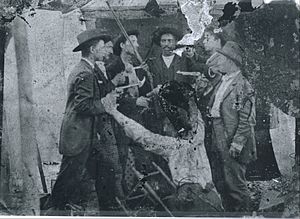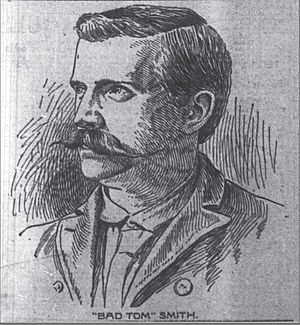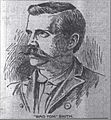French–Eversole feud
The French–Eversole feud was a series of fights and killings that happened in the mountains of southeastern Kentucky between 1887 and 1894. Most of the events took place in Hazard, Perry County. The main leaders were Joseph C. Eversole and Benjamin Fulton French. Both were businessmen and lawyers, and they used to be friends. This conflict became very famous and was reported in many newspapers across the United States. These news reports later became the basis for books written about the feud.
According to a report by General Sam Hill, more than 20 people died during the feud. Some historians have even claimed the number was as high as 74 deaths.
Contents
The Start of the Feud: Before the Conflict Began
Jacob Eversole (1760-1840) was one of the first people to settle in the area. He moved from Pennsylvania. His family name was originally spelled 'Ebersohl'. Six brothers from Europe came to Pennsylvania, and one of their sons, Jacob, moved to Eastern Kentucky around 1790-1800.
When Perry County was created in 1820, 'General' Elijah H. Combs named the main town Hazard. Both the county and the town were named after General Oliver Hazard Perry, a hero from the War of 1812. Hazard was a small town with only one road and a few buildings. It became the main trading center for the county, with about 100 people living there during the feud.
Jacob Eversole's son, 'Woolery' G. Eversole, married Lucy Cornett, whose family was also among the first settlers of Perry County, Kentucky. Woolery and Lucy had several children. One of them was Maj. John C. Eversole, who was a leader in the 14th Kentucky Cavalry during the Civil War and was killed. His son, Joseph C. Eversole, later became the leader of the Eversole family during the feud.
Joseph Eversole and Benjamin Fulton French were quite similar. They were both lawyers and successful merchants. Joseph Eversole married Susan Combs, who came from another important family in Perry County. Susan's great-grandfather, Elijah H. Combs, was the person who founded Hazard. French, however, was not from Kentucky. He came from Tennessee but married a woman from Kentucky, Susan Lewis. This marriage connected him to important families in other nearby counties. Both Joseph C. Eversole and Benjamin Fulton French owned competing stores in Hazard.
Why the Feud Started: Two Possible Reasons
There are two main ideas about what caused the feud. One is a more exciting story, but it might not be true. The other is more likely and makes more sense.
Cause 1: A Story About Love and Lies
The popular story says the feud started because of a disagreement over a woman. A clerk who worked in French's store was in love. One day, he saw the woman with Fulton French and became very jealous. The clerk then went to Joseph C. Eversole and told him that he had heard French say he wanted to kill Joe.
When Joe Eversole asked the clerk about these claims, the clerk stayed silent. Eversole warned him that his silence would make him believe the accusations were true. At first, Joe Eversole didn't believe the clerk. He asked the clerk to sign a sworn statement saying French planned to murder him. This made Eversole believe he needed protection, so he started gathering armed men. French soon did the same, and a conflict became unavoidable. Many believe this was the clerk's way of getting revenge on Fulton French.
Cause 2: Disagreements Over Coal Land
The more probable reason (or a mix of both stories) is that the two men were business rivals. After the Civil War, large companies began buying huge amounts of land to get the coal hidden beneath the mountains. French worked for one of these companies, buying coal rights from farmers who couldn't read or write. Eversole, as a local merchant, felt loyal to the long-time residents, many of whom were his relatives.
French wanted to buy the land for the lowest possible price for the big companies he worked for. Eversole saw this as cheating the farmers. He started traveling around the county, telling farmers that Fulton French would try to trick them into selling their 'coal rights' for very little money. French, not being from the area, didn't have the same concerns for the mountain people of Eastern Kentucky. The bad feelings between them grew until they both gathered their own groups of armed men. French reportedly paid his hired men $2 to $2.50 a day.
Key Killings: The Feud's Deadly Events
Ambushes were a common way of fighting in this feud. It was safer for the attackers, who could hide, and it was harder to figure out who was responsible. Many people lived in fear, and for good reason.
The Death of Silas Gayheart
The first person to die in the feud was Silas Gayheart, a friend of French. About a dozen white men and a couple of African-Americans reportedly ambushed and killed Gayheart. The Eversoles said they didn't do it, and some believed Gayheart was killed because of a different argument he had. However, French blamed the Eversole group.
One night, French left Hazard, possibly to gather more men to attack Eversole. When Eversole found out, he pulled his men back, leaving only a few in town. He waited for French to attack so he could surprise them. Neither side was fooled, and no one was hurt that time. When French finally returned to town in June 1887, Eversole went to meet him. The two sides had a shootout in town, but only one of French's men was wounded. After a day of shooting, French's men left.
These kinds of small fights happened throughout the summer of 1887. Paying their men every day started to cost the businessmen a lot of money, and they were almost out of cash. Both sides owned most of the large land in Perry County. They agreed to meet at Big Creek and made a peace agreement. They signed the written agreement with witnesses. The agreement said they could go home, would break up their armed groups, and give up their guns.
But the bad feelings remained. Soon after they had more money, French accused Eversole of taking his guns back from Judge Josiah Combs, who was Eversole's father-in-law. Eversole claimed French hadn't seen that, that French hadn't broken up his own group, and that the deal only meant giving up some guns. The short peace quickly ended.
The Killing of William 'Bill' Gambriel
The next big event happened on September 15, 1887. Joe Eversole and Bill Gambriel, who supported French and was a traveling preacher, started arguing in the street in Hazard. This turned into a fight. Some of Eversole's men shot at Gambriel and wounded him. As he tried to get away, another man, said to be an officer, shot him. As Gambriel turned away, Joe Eversole pulled out his pistol and shot Gambriel in the head, killing him instantly.
One man was tried for the killing. The first trial ended with no decision, and the second trial found him not guilty. Joe Eversole was not tried because witnesses said Gambriel had attacked Joe first.
The Assassination of Joseph C. Eversole
Things were calm through the winter until Sunday, April 15, 1888. Joe Eversole, his brother-in-law Nick Combs, and Judge Josiah Combs were going to Hyden for court. Judge Combs was riding a little ahead of Joe and Nick with a policeman, Tom Hollifield, who was taking a prisoner to Hyden. Josiah heard gunshots. He turned and saw Joe and Nick fall to the ground. Joe died almost right away.
After looking into it, it seemed the attackers had been camping for days, waiting for them. French was accused and officially charged, but he left town with a group of supporters because he feared revenge. No one was ever found guilty of the killings. However, seven years later, 'Bad Tom' Smith, a man who worked for French, confessed while he was about to be executed for another crime. He said that he and Joseph Adkins committed the murders because French told them to.
John Campbell Takes Over
After Joe Eversole died, John Campbell took over leading the fight against French. Campbell surrounded the town with guards, had men patrol the streets, and sent people to scout the countryside. He was afraid French would attack, so he only let people into town if they knew a secret password.
This plan actually led to his downfall. One night, Campbell found a guard sleeping and startled him. The guard shot Campbell, who died a month later from his injuries.
While Campbell was still alive, Shade Combs thought he could end the feud by killing French and a few of his men. Campbell gave him men, and Combs set out to do it. French found out about the plan and set up his own ambush. Combs escaped, but he was successfully ambushed and killed soon after at his home.
Death of Elijah Morgan
Elijah Morgan, who was Judge Josiah Combs' son-in-law and supported French, was the next person killed on October 9, 1888. He was working on an agreement with Frank Grace when he was ambushed. He wanted peace, and the Eversole group told him to meet them in Hazard to talk about a deal. This was a trick to get him there, and he was murdered. Many believe this was revenge for the death of Shade Combs, as their deaths happened very close together.
Kentucky Government Steps In
Judge Lilly, who was in charge of law in Perry and other counties, had had enough. He sent state troops to Hazard, and they arrived in early November 1888. He wrote to the governor on November 13, 1888, explaining the need for troops. He said he would not hold court in Perry and other counties without state guards because he feared shootings.
On November 14, 1888, Sam Hill, who was in charge of the state troops, wrote to Governor Buckner that only 35 people were left in town when they arrived. Many people came back after the troops arrived. Hill also noted that juries were connected to the fighting families or were afraid of the accused, which led to lawlessness. The court session in November 1888 went smoothly because the troops were in town.
The Battle of Hazard: A Town Under Fire
The Battle of Hazard happened on November 8, 1889. Campbell, who might have been drinking, fired his gun on Graveyard Hill. A storekeeper saw him shooting, aimed, and killed Campbell with one shot. The people in the courthouse heard the shot, thought it was part of the feud, and scattered.
The Eversole group took control of the courthouse, and French's men captured the jailhouse. Jesse Fields and Bob Profitt, both French supporters, escaped from the courthouse's second floor and made it to the jail. That night, they escaped the jailhouse to join the rest of French's group. Jesse Fields and 'Bad' Tom Smith then took the high ground on Graveyard Hill.
J. McKnight, an Eversole supporter, tried to run across the street with a friend to gain some ground, but French's men shot him dead. The Eversoles retreated across the river after they ran out of ammunition. They left Green Morris and one other person along the river bank so they could escape safely. When Jesse Fields and Tom Smith chased them, Morris opened fire and hit Fields in the arm. The Battle of Hazard was over.
The End of the Feud: Lasting Impacts
After the events in Hazard, the courthouse burned down on July 4, 1890, but the important records were saved.
The Death of Robin Cornett
Robin Cornett, who supported Eversole, finally returned home, hoping the feud was over. He was ambushed and killed in July 1890 when he went to cut a tree near his home.
This was the final breaking point for Judge Lilly. He came with state troops for a special court session in August 1890, which was held in a tent. They quickly brought up each person who was accused and sent them to Clark County to be tried. Lilly knew that no one would get a fair trial in Hazard, and he feared another battle. At first, no one was allowed to be released on bail. The jail became so full that they had to keep the men in a guarded tent. This "Blanket Court" worked well, and there were few problems until 1894.
The Assassination of Judge Josiah Combs
In 1894, Judge Josiah Combs decided to return to his beloved home, hoping the fighting had ended. He was ambushed and killed while talking with friends outside his house. A large field of corn was growing in Hazard. The killers, Joe Adkins, Jesse Fields, and Boone Frazier, hid in the corn and shot at Judge Combs.
None of this would have been known if 'Bad' Tom Smith hadn't been caught for a different killing and sentenced to face the death penalty for the murder of Dr. John E. Rader. He confessed while facing execution, explaining how Fulton French had planned the attack and that Joe Adkins had fired the shot that killed Judge Combs. French was found not guilty of the charges. Frazier was never caught. Fields was sentenced to life but found not guilty in a second trial. Adkins received a life sentence in both trials, but he only served 8 years before being released.
The Murder of B. Fulton French
After the events in Hazard, Fulton French started wearing a bulletproof vest. Years later, in 1913, French met Susan Eversole, Joe's widow, and her son Harry Clay Eversole (who was 28 at the time). Harry was sometimes called 'One Arm' Harry because he lost an arm as a child. Fulton said, "Good Morning, Mrs. Eversole." Harry pulled out his pistol and shot him. Harry was only charged a $75 penalty for disturbing the peace. French did die from the shot from 'One Arm' Harry, though it took him over a year to finally die from the wound in 1915.
Media Attention: How the Feud Was Reported
From 1886, when news spread that Benjamin Fulton French was gathering a private army to kill Joseph C. Eversole, the public and newspapers closely followed the French-Eversole Feud. They reported on the many trials, battles, accusations, and deaths of the people involved.
The feud was covered by many newspapers across the country, showing how much interest there was in this conflict.
Images for kids









